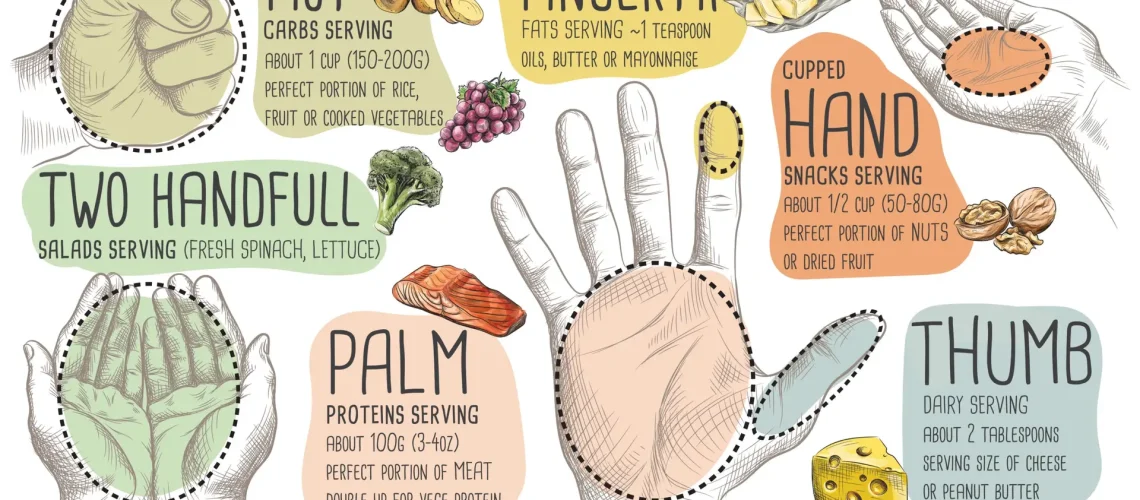When it comes to how much food you put on your plate, size really does matter – and yes, you can have too much of a good thing. Portion size plays a key role in managing calorie intake, maintaining nutrient balance, and supporting overall health. Eating the right amount – and the right proportions – ensures your body gets the nutrients it needs, reduces the risk of chronic disease, and helps with weight management.
What Is Portion Size?
Portion size refers to the amount of food you choose to eat at one time. Studies show that larger portions – especially of energy-dense foods – lead to greater calorie intake than your body needs, which inevitably causes weight gain over time. Bigger portions of less nutritious foods may also crowd out the more nutrient-rich options your body needs.
Why Portion Size Matters
1. Nutrient Balance
- Getting the Nutrients You Need: Appropriate portions from all food groups help you meet your daily energy (calories), protein, vitamin, mineral, and fibre needs.
- Avoiding Deficiencies: Not eating enough can lead to nutrient deficiencies, while overeating – especially less nutritious foods – may displace healthier options.
2. Health Benefits
- Easier Digestion: Smaller portions are easier on the digestive system.
- Stable Blood Sugar Levels: Balanced portions help regulate blood sugar levels, which is especially important for people with diabetes.
- Reduced Disease Risk: By managing calorie and nutrient intake, portion control helps manage weight and can reduce the risk of developing conditions like type 2 diabetes, heart disease, and some cancers.
3. Weight Management
- Preventing Weight Gain: Oversized portions lead to excess calorie intake and weight gain over time.
- Supporting Weight Loss: Controlling portion sizes can help create a calorie deficit, which is essential for weight loss – just don’t sacrifice nutrition in the process.
4. Mindful Eating
- Better Awareness: Watching portion sizes encourages a more intentional, conscious approach to eating.
- Avoiding Overeating: Portion control helps prevent overeating and the tendency to consume more food than the body needs.
Beyond Size: Think Nutrient Density
Portion control matters – but so does what you put on your plate. Choosing “nutrient-dense” foods helps you get more health benefits without extra calories.
Nutrient density refers to how much nutrition (vitamins, minerals, protein, fibre, healthy fats) a food provides relative to its calorie content. Whole foods tend to be nutrient-dense because they are typically unprocessed or minimally processed and retain their natural complement of vitamins, minerals, fibre, and other beneficial compounds. When you fill your plate with nutrient-dense foods, you can enjoy satisfying portions without overloading on calories.
Nutrient Density and Portion Size: A Healthy Balance
There’s often an inverse relationship between nutrient density and energy density. Nutrient-dense foods deliver more health benefits in fewer calories, while energy-dense foods (high in calories, low in nutrients) can lead to overconsumption with little nutritional payoff.
Choosing nutrient-dense foods allows you to eat enough to feel satisfied without consuming excess calories – a win for both health and weight management.
Examples of Nutrient-Dense Foods
- Animal-based foods: Especially organ meats (like liver and heart), grass-fed meats, poultry, seafood
- Full-fat dairy: Preferably minimally processed (e.g., fresh milk, kefir, natural yogurt, cheese)
- Fruits and vegetables: Particularly leafy greens, colourful veggies, avocados, and berries
- Nuts and seeds: Best raw or roasted without added salt or oils
- Legumes: Beans, lentils, and peas – rich in fibre and protein, though also high in carbohydrates
- Whole grains: Oats, quinoa, brown rice – sources of fibre, but very high in carbohydrates (starch) and low in other nutrients
Examples of Nutrient-Poor or “Empty-Calorie” Foods
These foods tend to be high in calories and low in nutritional value. When eaten frequently, they can displace healthier options and increase the risk of weight gain and chronic disease:
- Sugary drinks: Soft drinks, energy and sports drinks, fruit-flavoured drinks, and sweetened teas
- Sweets and candy: These are primarily made of sugar and unhealthy fats – practically zero nutrients
- Processed snacks: Chips (crisps), crackers, cookies, pastries – loaded with refined carbs, unhealthy fats, and often very high in sodium (salt)
- Fried foods: French fries, fried chicken, and similar items absorb large amounts of oil during cooking
- Processed meats: Hot dogs, most deli meats and sausages – high in saturated fats, sodium and preservatives
- Baked desserts: Cakes, pies, and pastries tend to be both calorie-dense and nutrient-poor
How can I keep track of how much I eat?
Checking food labels for calories per serving is one step toward managing your food portions.
Final Thoughts
Portion control and food quality go hand in hand. Paying attention to how much you eat – and what you eat – can make a big difference in how you feel, how your body functions, and how you age.
You don’t need to obsess over every bite. Instead, aim for balanced portions of nutrient-dense foods, and keep highly processed, low-nutrient foods as occasional treats rather than everyday staples.
Eat just enough for you – and let your body, not your plate size, be your guide.

